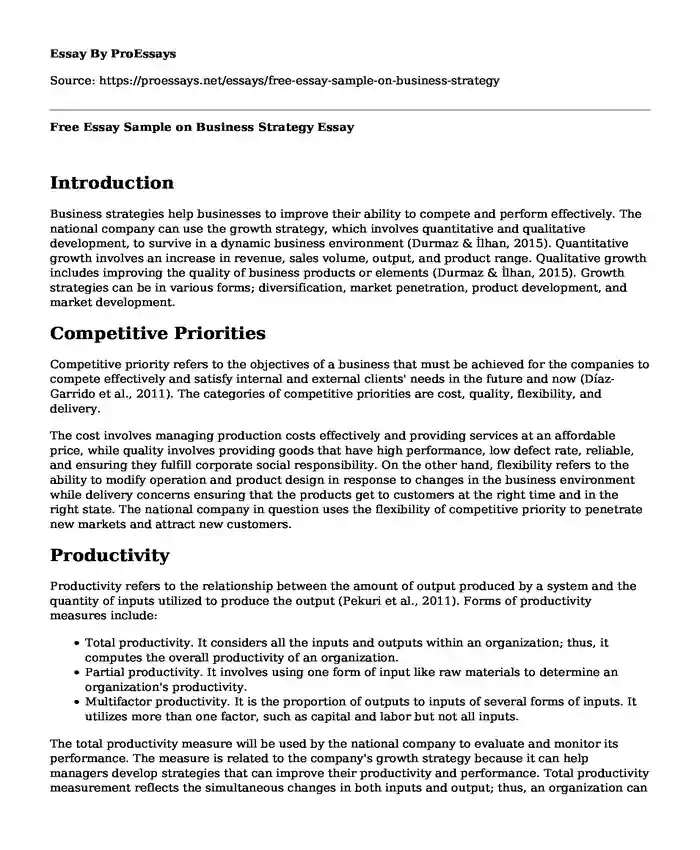Introduction
Business strategies help businesses to improve their ability to compete and perform effectively. The national company can use the growth strategy, which involves quantitative and qualitative development, to survive in a dynamic business environment (Durmaz & Ilhan, 2015). Quantitative growth involves an increase in revenue, sales volume, output, and product range. Qualitative growth includes improving the quality of business products or elements (Durmaz & Ilhan, 2015). Growth strategies can be in various forms; diversification, market penetration, product development, and market development.
Competitive Priorities
Competitive priority refers to the objectives of a business that must be achieved for the companies to compete effectively and satisfy internal and external clients' needs in the future and now (Díaz-Garrido et al., 2011). The categories of competitive priorities are cost, quality, flexibility, and delivery.
The cost involves managing production costs effectively and providing services at an affordable price, while quality involves providing goods that have high performance, low defect rate, reliable, and ensuring they fulfill corporate social responsibility. On the other hand, flexibility refers to the ability to modify operation and product design in response to changes in the business environment while delivery concerns ensuring that the products get to customers at the right time and in the right state. The national company in question uses the flexibility of competitive priority to penetrate new markets and attract new customers.
Productivity
Productivity refers to the relationship between the amount of output produced by a system and the quantity of inputs utilized to produce the output (Pekuri et al., 2011). Forms of productivity measures include:
- Total productivity. It considers all the inputs and outputs within an organization; thus, it computes the overall productivity of an organization.
- Partial productivity. It involves using one form of input like raw materials to determine an organization's productivity.
- Multifactor productivity. It is the proportion of outputs to inputs of several forms of inputs. It utilizes more than one factor, such as capital and labor but not all inputs.
The total productivity measure will be used by the national company to evaluate and monitor its performance. The measure is related to the company's growth strategy because it can help managers develop strategies that can improve their productivity and performance. Total productivity measurement reflects the simultaneous changes in both inputs and output; thus, an organization can evaluate what needs to be increased and decreased.
Technology
Information technology refers to several forms of hardware and software used in the transfer and processing of information. It ensures proper flow of organization within an organization and helps maintain appropriate customer care services. On the other hand, physical technology refers to any form of technology that exists physically and is tangible. It includes production machinery, networking devices, and raw materials. Business technology refers to using engineering, science, and data to achieve business objectives such as economic growth and increased customer base (Nguyen et al., 2015).
The role of technology is to ensure companies improve their products' quality and the speed of their production processes using innovative methods. The national company in question should invest in physical technology such as packaging and processing machines to improve their products' quality and differentiate them from their competitors.
Conclusion
The growth strategy helps businesses succeed by understanding their market correctly, which allows them to gain advantages over their rivals and become resilient during a crisis. Companies can seize new opportunities and gain customer loyalty by providing quality products.
References
Díaz-Garrido, E., Martín-Peña, M. L., & Sánchez-López, J. M. (2011). Competitive priorities in operations: Development of an indicator of strategic position. CIRP Journal of Manufacturing Science and Technology, 4(1), 118-125. https://doi.org/10.1016/j.cirpj.2011.02.004
Durmaz, Y., & Ilhan, A. (2015). Growth strategies in busynesses and a theoretical approach. International Journal of Business and Management, 10(4), 210.
http://dx.doi.org/10.5539/ijbm.v10n4p210
Nguyen, T. H., Newby, M., & Macaulay, M. J. (2015). Information technology adoption in small business: Confirmation of a proposed framework. Journal of Small Business Management, 53(1), 207-227. https://www.tandfonline.com/doi/abs/10.1111/jsbm.12058
Pekuri, A., Haapasalo, H., & Herrala, M. (2011). Productivity and performance management–managerial practices in the construction industry. International Journal of Performance Measurement, 1(1), 39-58. https://www.researchgate.net/profile/Harri_Haapasalo/publication/265175596_Productivity_and_performance_management_-_Managerial_practices_in_the_construction_industry/links/54a1364a0cf256bf8bae4c37.pdf.
Cite this page
Free Essay Sample on Business Strategy. (2024, Jan 01). Retrieved from https://proessays.net/essays/free-essay-sample-on-business-strategy
If you are the original author of this essay and no longer wish to have it published on the ProEssays website, please click below to request its removal:
- Classification of Types of Bosses and Supervisors
- Managing Disaster Risk Through Climate Adaptation Paper Example
- Upgrade of the Information Technology Infrastructure of Zara Paper Example
- A Budgeting Crisis at Little State University: Case Study
- Essay on Dr. Thomas Gives Daughter Shares as Limited Partnership Interests
- Free Report Example on John Hopkins Hosp.: Improving Ops. for Optimal Resource Use
- Implementing Policy in the Health Care System







